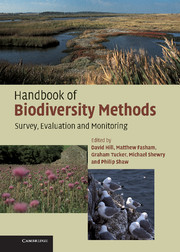Book contents
- Frontmatter
- Contents
- Preface
- Acknowledgements
- Part I Planning
- Part II Habitats
- Part III Species
- Appendix 1 Monitoring and reporting obligations under international conservation agreements
- Appendix 2 Relationship between BAP Priority Habitat and Broad Habitat categories and Habitats Directive nomenclature
- Appendix 3 Annotated list of key references for plant identification
- Appendix 4 Determining appropriate quadrat size for vegetation sampling
- Appendix 5 The relocation of permanent plots
- Appendix 6 Equipment required for undertaking different types of survey
- Recommended sources of further information
- References
- Glossary
- Index
Appendix 5 - The relocation of permanent plots
Published online by Cambridge University Press: 01 September 2010
- Frontmatter
- Contents
- Preface
- Acknowledgements
- Part I Planning
- Part II Habitats
- Part III Species
- Appendix 1 Monitoring and reporting obligations under international conservation agreements
- Appendix 2 Relationship between BAP Priority Habitat and Broad Habitat categories and Habitats Directive nomenclature
- Appendix 3 Annotated list of key references for plant identification
- Appendix 4 Determining appropriate quadrat size for vegetation sampling
- Appendix 5 The relocation of permanent plots
- Appendix 6 Equipment required for undertaking different types of survey
- Recommended sources of further information
- References
- Glossary
- Index
Summary
Various techniques (e.g. quadrats and transects) have been used to mark permanent plots; these are described briefly below. A general point to consider is that the more techniques used, the quicker it will normally be to find plots again.
MAPPING
Measurements to nearby features have been widely used to map locations of plots and are relatively foolproof, provided that mapping is accurate (use a backsighting compass for bearings and measure distances correctly) and that the features chosen are fixed and permanent. This is particularly important for long-term monitoring studies; features such as fence posts may be damaged or lost over time. However, the method is often difficult to apply in large homogeneous habitats, such as grasslands, where obvious permanent features are lacking. It is also time-consuming when a large number of plots need to be relocated.
MARKER POSTS
Wooden or metal posts are widely used and can be quick to re-find in relatively small sites. However, small markers can be hidden by vegetation. Large markers can cause significant damage to habitats, tend to be unsightly and attract the attention of people. Animals too may scratch against large markers, thereby causing disproportionate disturbance to vegetation, resulting in bias in the sampling. Unless markers are strong and well secured they may be broken by livestock or removed by vandals, etc. Posts may also be lost over time through rotting or corrosion and even frost heave.
PAINT
Paint has been used to mark plots, especially where rocks, walls or posts are available nearby.
- Type
- Chapter
- Information
- Handbook of Biodiversity MethodsSurvey, Evaluation and Monitoring, pp. 495 - 496Publisher: Cambridge University PressPrint publication year: 2005



